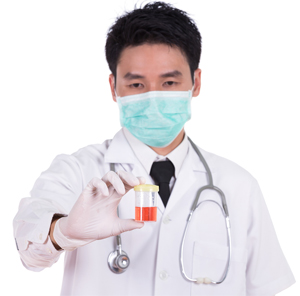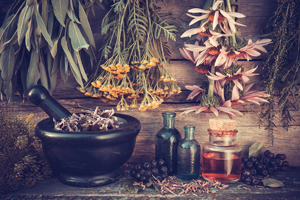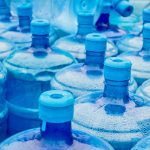This newsletter is really about two separate but related issues: first, the continuing attack against proven alternative health remedies through the use of highly publicized, but deeply flawed studies and second, the push by the medical industry, drug companies, and elected officials to turn alternative health–and especially herbal remedies–into a heavily regulated subdivision of the pharmaceutical industry. So, what’s the specific trigger for today’s newsletter?
The media is continually using deeply flawed studies to attack proven alternative health remedies.
On Nov 8th, the Journal of the American Medical Association published the results of a study that looked at the question: do cranberry capsules with sufficient proanthocyanidin content affect the presence of bacteriuria (the presence of bacteria in the urine) plus pyuria (the presence of pus in the urine) in older women living in nursing homes?1 Manisha Juthani-Mehta, Peter H. Van Ness, Luann Bianco, et al. “Effect of Cranberry Capsules on Bacteriuria Plus Pyuria Among Older Women in Nursing Homes, A Randomized Clinical Trial.” Nov 8, 2016. JAMA. 2016;316(18):1879-1887. http://jamanetwork.com/journals/jama/article-abstract/2576822 (Note: these conditions are highly prevalent among older women living in nursing homes.) And the short answer, according to the study, was no. Among older women living in nursing homes, cranberry capsules, compared with placebo, did not have a significant effect on the presence of bacteriuria plus pyuria over one year. Not surprisingly, the press went to town with these results.
- “More Evidence Cranberries Don’t Prevent Urinary Tract Infections.” Reuters.2 Andrew M. Seaman. “More Evidence Cranberries Don’t Prevent Urinary Tract Infections.” Reuters. (Accessed 31 Oct 2016.) http://www.reuters.com/article/us-health-women-cranberries-utis-idUSKCN12R2II
- “Cranberries squashed as folk remedy.” CNBC/AP.3 Lindsey Tanner. “Cranberries squashed as folk remedy.” CNBC/AP. October 27, 2016. (Accessed 31 Oct 2016.) http://www.cnbc.com/2016/10/27/the-associated-press-cranberries-squashed-as-folk-remedy-for-urinary-infections.html
- “Cranberry Juice and Urinary Tract Infections — a Myth?” Liberty Voice.4 Dyanne Weiss. “Cranberry Juice and Urinary Tract Infections — a Myth?” Liberty Voice. October 29, 2016. (Accessed 31 Oct 2016.) http://guardianlv.com/2016/10/cranberry-juice-urinary-tract-infections-myth/
- “Urinary Tract Infections (UTIs) Not Helped By Taking Cranberry-Based Products, Study Finds.” Huffington Post Lifestyle.5 Natasha Hinde. “Urinary Tract Infections (UTIs) Not Helped By Taking Cranberry-Based Products, Study Finds.” Huffington Post Lifestyle. 31/10/2016. (Accessed 31 Oct 2016.) http://www.huffingtonpost.co.uk/entry/cranberry-products-do-not-help-reduce-urinary-tract-infections-in-women_uk_58170ddfe4b0672ea689171d
- “Cranberry products can’t cure UTIs.” Consumnes Connection.6 Joanne Flowers. “Cranberry products can’t cure UTIs.” Consumnes Connection. Oct 31, 2016. (Accessed 31 Oct 2016.) http://crcconnection.com/2016/10/31/cranberry-products-cant-cure-utis.html
Effect of Cranberry Capsules on Bacteriuria Plus Pyuria Among Older Women in Nursing Homes, A Randomized Clinical Trial
 This was a double-blind, randomized, placebo-controlled, efficacy trial involving 185 women aged 65 years or older, residing in 21 nursing homes located within 50 miles (80 km) of New Haven, Connecticut (August 24, 2012-October 26, 2015).
This was a double-blind, randomized, placebo-controlled, efficacy trial involving 185 women aged 65 years or older, residing in 21 nursing homes located within 50 miles (80 km) of New Haven, Connecticut (August 24, 2012-October 26, 2015).
Patients were given two oral cranberry capsules, with each capsule containing 36 mg of the active ingredient proanthocyanidin (i.e., 72 mg total, equivalent to 20 ounces of cranberry juice) vs placebo administered once a day in 92 treatment and 93 control group participants. The capsules used were from the French pharmaceutical company, Pharmatoka and, as stated, were standardized to 36 mg of cranberry proanthocyanidins.7 http://pharmatoka.com/en/pharmatoka-equipe.php It should be noted that in 2004, the French Food Safety Agency (AFSSA) granted, as a worldwide first, a physiological health claim for Pharmatoka’s cranberry capsules, validating its antibacterial and anti-adhesive effects, as well as its ability to reduce recurrent urinary tract infections caused by uropathogenic E. coli. That said, it should also be noted that Pharmatoka itself built the dossier and petitioned the French Government for this health claim.
Of the 185 randomized study participants (mean age, 86.4 years) with bacteriuria plus pyuria at baseline), 147 completed the study. The adjusted data showed no significant difference in the presence of bacteriuria plus pyuria between the treatment group vs the control group (29.1% vs 29.0%). There were no significant differences in the number of symptomatic UTIs (10 episodes in the treatment group vs 12 in the control group), or rates of death (17 vs 16). On the other hand, there were small but observable differences in the rates of hospitalization (33 vs 50 admissions), bacteriuria associated with multidrug-resistant gram-negative bacilli (9 vs 24 episodes), and antibiotics administered for suspected UTIs (692 vs 909 antibiotic days). In other words, although the capsules didn’t do the key things that were looked for, they definitely provided some benefits.
So, Was the Study Valid and Did the Press Get Their Headlines Right?
 Well, the answer to the first question is neither black or white, but rather, a whole lot of gray. And as to the press reporting the story accurately, the answer would have to be a resounding “as if.” Let’s explore.
Well, the answer to the first question is neither black or white, but rather, a whole lot of gray. And as to the press reporting the story accurately, the answer would have to be a resounding “as if.” Let’s explore.
In fact, there are studies that have shown that cranberry consumption has prophylactic effects against urinary tract infections (UTI), although the mechanisms involved are not completely understood. Certainly, most of the focus has been on the antioxidant proanthocyanidin content, which is why the study used cranberry capsules standardized for that content. However, a 2015 study found, in fact, that other compounds in cranberries may actually play a greater role.8 de Llano DG, Esteban-Fernández A, Sánchez-Patán F, Martínlvarez PJ, Moreno-Arribas MV, Bartolomé B. “Anti-Adhesive Activity of Cranberry Phenolic Compounds and Their Microbial-Derived Metabolites against Uropathogenic Escherichia coli in Bladder Epithelial Cell Cultures.” Int J Mol Sci. 2015 May 27;16(6):12119-30. http://www.ncbi.nlm.nih.gov/pmc/articles/PMC4490433/ Specifically, the study found that catechol, benzoic acid, vanillic acid, phenylacetic acid and 3,4-dihydroxyphenylacetic acid all showed anti-adhesive activity against E. coli, whereas procyanidin A2, widely reported as an inhibitor of E. coli adherence in the urinary tract was far less significant. In other words, if you standardize a capsule exclusively for proanthocyanidins, you’re going to be leaving out the most important elements.
And then there’s the simple sugar D-mannose. Cranberries contain D-mannose. There are a number of studies that have shown that D-mannose powder can significantly reduced the risk of recurrent UTIs at a level equivalent to the pharmaceutical antibiotic Nitrofurantoin.9 Kranjcec B, Papeš D, Altarac S. “D-mannose powder for prophylaxis of recurrent urinary tract infections in women: a randomized clinical trial.” World J Urol. 2014 Feb;32(1):79-84. http://www.ncbi.nlm.nih.gov/pubmed/23633128 Then there’s the 2015 study published in the European Review for Medical and Pharmacological Sciences that found that D-mannose has a significant positive effect on UTIs’ resolution, not to mention a marked improvement in the quality of life.10 Domenici L, Monti M, Bracchi C, Giorgini M, Colagiovanni V, Muzii L, Benedetti Panici P. “D-mannose: a promising support for acute urinary tract infections in women. A pilot study.” Eur Rev Med Pharmacol Sci. 2016 Jul;20(13):2920-5. http://www.europeanreview.org/article/11121 And the same study also found that as a UTI prophylactic agent administered for 6 months, it reduced the rate of recurrence from 33.3% to a mere 4.5%.
Incidentally, you might be curious as to how D-mannose works. Well, UTIs start when E. coli bacteria migrate from the anus to the bladder and penetrate the protective coating that lines the bladder. In most cases, urine flow washes out bacteria from the bladder before it can penetrate the coating. But the cell walls of E. coli bacteria have tiny finger-like projections that contain complex molecules called lectins on their surface. These lectins are like cellular glue that binds the bacteria to the bladder wall so they cannot be easily rinsed out by urination.11 Gregory G. Anderson1, Joseph J. Palermo1, Joel D. Schilling, et al. “Intracellular Bacterial Biofilm-Like Pods in Urinary Tract Infections.” Science 04 Jul 2003: Vol. 301, Issue 5629, pp. 105-107. http://science.sciencemag.org/content/301/5629/105.abstract Quite simply, the chemical structure of D-Mannose causes it to bind to the E. coli lectins before the lectins can bind to the urinary tract lining and bladder wall–thus preventing them from sticking to the tract lining and allowing the urine to easily flush the bacteria out of the body.12 Bouckaert J, Berglund J, Schembri M, et al. “Receptor binding studies disclose a novel class of high-affinity inhibitors of the Escherichia coli FimH adhesin.” Mol Microbiol. 2005 Jan;55(2):441-55. http://onlinelibrary.wiley.com/doi/10.1111/j.1365-2958.2004.04415.x/full , 13 Ofek I, Goldhar J, Eshdat Y, Sharon N. “The importance of mannose specific adhesins (lectins) in infections caused by Escherichia coli.” Scand J Infect Dis Suppl. 1982;33:61-7. http://www.ncbi.nlm.nih.gov/pubmed/6753135?dopt=Abstract
So, once again, if you’re only standardizing your capsules for proanthocyanidins, you’re not going to get adequate levels of D-Mannose in your capsules and thus lose a significant portion of cranberries’ protective effect. That said, it’s probably worth noting that a study published earlier this year in the American Journal of Obstetrics and Gynecology found that cranberry capsules lowered the risk of UTIs by 50%. In the cranberry treatment group, 19% of patients developed a UTI, compared with 38% of the placebo group. The capsules used in this study, however, were not Pharmatoka’s but TheraCran HP.14 http://www.theralogix.com/sp/theralogix-theracran-hp/
The bottom line is that the media headlines got it wrong when they said, “Cranberries Don’t Prevent Urinary Tract Infections.” In fact, the only thing that the latest study showed is that Pharmatoka’s standardized cranberry capsules didn’t prevent UTIs, at least in this study. Generalizing that result to all cranberry products is absurd. But, to be fair to the media, the study’s authors didn’t make that clarification either. Which brings us to the issue of standardization, a favorite pet peeve of mine.
The Problem with Standardized Extracts
As I explained in Lessons from the Miracle Doctors, almost everyone now believes that standardized extracts are a good thing. They answer the medical community’s need for predictable doses and effects. All of the top herbal manufacturers now promote their use of standardized herbs. To a large degree, though, I believe it’s a red herring. Although for some formulas I will incorporate standardized herbs–and even then, I try and use standardized herbal complexes rather than isolates–in general I’m not a big fan of them. Let me explain.
To understand what standardization means, let’s take a look at orange juice. (Yes, I know it’s not an herb, but it’s an easily understood example that everyone can relate to.) The orange juice you buy in the store, either in half-gallon containers or as frozen concentrate, unless it’s sold as freshly squeezed, is actually a great example of a standardized product. The manufacturers of these juice products have been able to identify the “active ingredients” of orange juice that are primarily responsible for taste. In the case of orange juice, those key ingredients are sugar (sweetness) and acid (tartness). Now, the way standardization works with orange juice is that if a manufacturer finds that a batch of oranges is not sweet enough, they’ll blend the juice from that batch with the juice from a much sweeter batch to bring it up to the “ideal” sweetness. If that same batch is too acidic, they’ll blend it with a batch that’s less acidic, until their testing shows that it’s reached just the right level of acidity. That’s why each can or container of orange juice you buy tastes pretty much like the one you bought the week before. That’s standardization.
So, what’s the problem?
Have you ever tasted a can of frozen orange juice or juice from a container that even comes close to the taste of good fresh squeezed? (Don’t bother answering this question if you think that SunnyD® tastes better than real orange juice.) While standardization can make one batch virtually identical to the next, it can never make any batch as good as really good non-standardized fresh squeezed. The reasons are simple. First, for the most part, standardized orange juice starts with mass-produced, lower grade oranges. Standardization is required because you’re starting with an inferior product. Second, the taste of orange juice is governed by far more factors than sugar and acid. It is the result of the interplay of dozens of natural flavors, esters, and oils that are beyond the ability of any manufacturer to control. It is a symphony of taste, a symphony that we cannot duplicate by tweaking one or two “active” ingredients. In fact, tweaking is actually often deleterious because it destroys the natural balance of all those factors that are not standardized.
 The process for standardizing herbs is a bit different than standardizing orange juice. With herbs, the active biochemicals are extracted from the herbs in liquid form, “standardized,” and then “sprayed” back onto a neutral plant base until the desired concentration of active biochemicals is realized. The net result, however, is the same.
The process for standardizing herbs is a bit different than standardizing orange juice. With herbs, the active biochemicals are extracted from the herbs in liquid form, “standardized,” and then “sprayed” back onto a neutral plant base until the desired concentration of active biochemicals is realized. The net result, however, is the same.
The problem with standardization is that it lowers the bar as to what we can expect from herbal formulations. Standardized formulas will never match the quality (and healing power) of a non-standardized formula made from the highest quality herbs, because the standardized formula seeks to control a few “identified” active ingredients at the expense of all the other “active” ingredients. Standardization distorts plant synergy, and it disrupts the natural ratios of ingredients inherent in the plant itself and replaces them with arbitrary ratios. In addition, the attempt to identify active ingredients is fundamentally flawed. The procedure used is right out of standard drug testing: isolate individual chemical components and test their effects one at a time in a test tube.
If a particular biochemical from an herb tests as “non-active,” it is eliminated from standardization of that herb. But what if that component has a different value in the grand scheme of things? What if, even though it may do nothing by itself, its presence makes another component truly effective? In that case, you could have a standardized herbal extract that is virtually useless. Green tea is an interesting case in point. Check any label for standardized green tea and it will state the percentages of polyphenols it’s standardized for, but what about theanine? Theanine is an important biochemical found in green tea, but it’s an amino acid, not a polyphenol. And that means that every standardized green tea extract that you buy is standardized for polyphenols, but never for theanine.
An obvious question might be: “If what I’m saying is true, then why is ‘everybody’ standardizing their herbs?” The answer is that standardization is the herbalists’ answer to traditional medicine’s complaint that herbs are unpredictable. Another way of saying this is that standardized extracts make herbs more like drugs. But herbs are not drugs. They are not single chemicals but rather a synergistic blend of natural compounds. Once you acknowledge this, the whole idea of standardization is revealed for what it is–co-option.
Is standardization useless? No, it definitely can give an indication of potency, particularly when using concentrated extracts, but it is by no means the ultimate arbiter of herbal quality. So, what’s the alternative? Well, one thing that we do know about herbs, through centuries of use, is that high quality herbs have great healing powers. We also know that well-grown herbs are consistently high in all active ingredients–those that we can identify and those that we won’t know about for another hundred years. The bottom line, then, is that if you must guarantee something, then why not:
- Use high-quality herbs with their natural ratios of ingredients. This means, of course, that you can’t “doctor up” poor quality herbs as you can with standardization.
- Guarantee a minimum level of potency for all active ingredients (as we know them today). This is a level determined by the initial quality of the herb, not by human manipulation of some arbitrary numbers, and, therefore, this keeps the natural ratios of all biochemicals intact.
This strategy provides all of the advantages of standardization and none of the negatives.
Conclusion
As I mentioned at the top, this newsletter really has been about two things:
First, don’t necessarily believe the mainstream media when they cite a “new” study that trashes some aspect of alternative health. As I’ve pointed out previously, they’re not actually researching the validity of the study. They’re merely repeating what they’ve been sent by the wire services with whom they contract; in most cases, that’s Reuters and the Associated press. And those services are in the business of simplifying medical studies so that they can be understood by the average fifth grader and finding a way to make them newsworthy. And that means they often take things out of context or exaggerate a point in the study to make the study seem punchier. Thus, the outrageous headlines you see in the news stories. The bottom line is that just because you see something on multiple news sites doesn’t mean it’s real. It only means that the wire service did their job and convinced the media to run the story.
 And second, the push we’re seeing from Attorneys General and congressional leaders to treat alternative remedies more like pharmaceutical drugs is counterproductive nonsense. As we’ve discussed in this newsletter, it often gets you an inferior product. And as I’ve discussed many times before, this is not a new idea–we’ve gone down this road before, with disastrous consequences. The entire pharmaceutical/drug industry is an outgrowth of the herbal industry. In fact, the word “drug” comes from the old Dutch/German word “droog,” which refers to the process used to dry herbs to turn them into medicines. Many, many prescription drugs are still based on the active ingredients found in medicinal plants. Tamiflu is a plant extract from the Chinese star anise. Digitalis is derived from foxglove, aspirin from white willow bark, and Tamoxifen from the Pacific yew to name just a few.
And second, the push we’re seeing from Attorneys General and congressional leaders to treat alternative remedies more like pharmaceutical drugs is counterproductive nonsense. As we’ve discussed in this newsletter, it often gets you an inferior product. And as I’ve discussed many times before, this is not a new idea–we’ve gone down this road before, with disastrous consequences. The entire pharmaceutical/drug industry is an outgrowth of the herbal industry. In fact, the word “drug” comes from the old Dutch/German word “droog,” which refers to the process used to dry herbs to turn them into medicines. Many, many prescription drugs are still based on the active ingredients found in medicinal plants. Tamiflu is a plant extract from the Chinese star anise. Digitalis is derived from foxglove, aspirin from white willow bark, and Tamoxifen from the Pacific yew to name just a few.
The apparent “benefit” behind the development of pharmaceuticals was to create purer, more potent, and more effective “medicines” than were found in the herbs themselves. Unfortunately, as we now know, the net result was, in many cases, just the opposite–less effective medicines with a whole range of deadly side effects. Pharmaceuticals, however, do offer one major advantage over herbs: they are patentable and, as such, generate billions of dollars in profits for the companies that manufacture them and the medical system that distributes them. Ultimately, there are several fundamental problems with this whole process of trying to medically standardize herbs:
- First, as we’ve already alluded to, no testing process in the world can measure the synergistic effect of all the biochemical components in herbs. No testing process can determine if a compound, even though it may not be biologically active itself, serves to increase the biological activity of another compound. That’s why no testing process can match the skill of the professional herbalist in determining the effectiveness of an herb–just as no testing process can match the nose and palate of a professional wine taster.
- It reinforces the paradigm of herbs as drugs–that is, for symptom X, you should take herb Y. And it puts herbal medicine in the hands of doctors (who, as a rule, have no understanding of herbal medicine) and takes it out of the hands of the herbal professionals.
- It actually leads to the classification of herbs as drugs, as the FDA has already done for fish oil.15 Kurt C. “Lovaza VS Fish Oil: What Makes One a Drug, the Other a Supplement?” Swanson. Saturday, April 5, 2014. (Accessed 10 Nov 2016.) http://www.swansonvitamins.com/blog/natural-health-randd/lovaza-vs-fish-oil-what-makes-one-a-drug-the-other-a-supplement
- It totally ignores the other aspects of herbal quality.
- It significantly raises costs.
- And when you’re talking about antipathogenic herbs, isolating key ingredients allows germs to quickly mutate around them. Several examples of herbs that had been effective antipathogens throughout human history only to be rendered largely ineffective in a matter of just a few years once medical science got hold of them include: Chinese star anise/Tamiflu and Wormwood/Artemisinin.
The global alternative wellness industry topped 500 billion dollars in 2013.16 “Market size of the global wellness industry in 2013, by segment (in billion U.S. dollars.” The Statistics Portal. (Accessed 5 May 2015.) http://www.statista.com/statistics/270720/market-size-of-the-wellness-industry-by-segment/ A half trillion dollars represents a lot of unhappiness with mainstream medicine and its pharmaceutical options. Do we really want to see the supplement industry placed under the control of the medical and pharmaceutical industries–to once again see supplements turned into drugs? Do we really want to return to the days when mainstream medicine controlled everything and we had no health options other than surgery and pharmaceutical drugs? Do we really want to return to the days when there were no natural options?
The global alternative wellness industry topped 500 billion dollars in 2013.
Enough with the hugely flawed studies that are heavily promoted by the media with the effect of undermining the validity of the supplement industry so that people won’t care about new, highly restrictive regulations that essentially eliminate the “alternative” in alternative medicine. And to those who say, more regulation only makes sense, I remind them of the old saying: “Be careful what you wish for because you just might get it.”

And with that I wish you a Happy New Year, I’m taking the month of December off from writing newsletters to work on some special projects. Also, I invite you all to join Kristen and me in our annual post-holiday liver/blood detox. January 4th-8th, with the 4-day, preparatory kidney detox taking place the last week in December. We consider this detox so important that we haven’t missed one in over 15 years.
References
| ↑1 | Manisha Juthani-Mehta, Peter H. Van Ness, Luann Bianco, et al. “Effect of Cranberry Capsules on Bacteriuria Plus Pyuria Among Older Women in Nursing Homes, A Randomized Clinical Trial.” Nov 8, 2016. JAMA. 2016;316(18):1879-1887. http://jamanetwork.com/journals/jama/article-abstract/2576822 |
|---|---|
| ↑2 | Andrew M. Seaman. “More Evidence Cranberries Don’t Prevent Urinary Tract Infections.” Reuters. (Accessed 31 Oct 2016.) http://www.reuters.com/article/us-health-women-cranberries-utis-idUSKCN12R2II |
| ↑3 | Lindsey Tanner. “Cranberries squashed as folk remedy.” CNBC/AP. October 27, 2016. (Accessed 31 Oct 2016.) http://www.cnbc.com/2016/10/27/the-associated-press-cranberries-squashed-as-folk-remedy-for-urinary-infections.html |
| ↑4 | Dyanne Weiss. “Cranberry Juice and Urinary Tract Infections — a Myth?” Liberty Voice. October 29, 2016. (Accessed 31 Oct 2016.) http://guardianlv.com/2016/10/cranberry-juice-urinary-tract-infections-myth/ |
| ↑5 | Natasha Hinde. “Urinary Tract Infections (UTIs) Not Helped By Taking Cranberry-Based Products, Study Finds.” Huffington Post Lifestyle. 31/10/2016. (Accessed 31 Oct 2016.) http://www.huffingtonpost.co.uk/entry/cranberry-products-do-not-help-reduce-urinary-tract-infections-in-women_uk_58170ddfe4b0672ea689171d |
| ↑6 | Joanne Flowers. “Cranberry products can’t cure UTIs.” Consumnes Connection. Oct 31, 2016. (Accessed 31 Oct 2016.) http://crcconnection.com/2016/10/31/cranberry-products-cant-cure-utis.html |
| ↑7 | http://pharmatoka.com/en/pharmatoka-equipe.php |
| ↑8 | de Llano DG, Esteban-Fernández A, Sánchez-Patán F, Martínlvarez PJ, Moreno-Arribas MV, Bartolomé B. “Anti-Adhesive Activity of Cranberry Phenolic Compounds and Their Microbial-Derived Metabolites against Uropathogenic Escherichia coli in Bladder Epithelial Cell Cultures.” Int J Mol Sci. 2015 May 27;16(6):12119-30. http://www.ncbi.nlm.nih.gov/pmc/articles/PMC4490433/ |
| ↑9 | Kranjcec B, Papeš D, Altarac S. “D-mannose powder for prophylaxis of recurrent urinary tract infections in women: a randomized clinical trial.” World J Urol. 2014 Feb;32(1):79-84. http://www.ncbi.nlm.nih.gov/pubmed/23633128 |
| ↑10 | Domenici L, Monti M, Bracchi C, Giorgini M, Colagiovanni V, Muzii L, Benedetti Panici P. “D-mannose: a promising support for acute urinary tract infections in women. A pilot study.” Eur Rev Med Pharmacol Sci. 2016 Jul;20(13):2920-5. http://www.europeanreview.org/article/11121 |
| ↑11 | Gregory G. Anderson1, Joseph J. Palermo1, Joel D. Schilling, et al. “Intracellular Bacterial Biofilm-Like Pods in Urinary Tract Infections.” Science 04 Jul 2003: Vol. 301, Issue 5629, pp. 105-107. http://science.sciencemag.org/content/301/5629/105.abstract |
| ↑12 | Bouckaert J, Berglund J, Schembri M, et al. “Receptor binding studies disclose a novel class of high-affinity inhibitors of the Escherichia coli FimH adhesin.” Mol Microbiol. 2005 Jan;55(2):441-55. http://onlinelibrary.wiley.com/doi/10.1111/j.1365-2958.2004.04415.x/full |
| ↑13 | Ofek I, Goldhar J, Eshdat Y, Sharon N. “The importance of mannose specific adhesins (lectins) in infections caused by Escherichia coli.” Scand J Infect Dis Suppl. 1982;33:61-7. http://www.ncbi.nlm.nih.gov/pubmed/6753135?dopt=Abstract |
| ↑14 | http://www.theralogix.com/sp/theralogix-theracran-hp/ |
| ↑15 | Kurt C. “Lovaza VS Fish Oil: What Makes One a Drug, the Other a Supplement?” Swanson. Saturday, April 5, 2014. (Accessed 10 Nov 2016.) http://www.swansonvitamins.com/blog/natural-health-randd/lovaza-vs-fish-oil-what-makes-one-a-drug-the-other-a-supplement |
| ↑16 | “Market size of the global wellness industry in 2013, by segment (in billion U.S. dollars.” The Statistics Portal. (Accessed 5 May 2015.) http://www.statista.com/statistics/270720/market-size-of-the-wellness-industry-by-segment/ |












When I first saw your
When I first saw your headline, I thought you were going to mention the shakedown being performed by Google, Amazon, etc. in the form of them adhering to LegitScript … a front for big pharma to shut down advertising and marketing for alternative meds.
If you don’t get approved by LegitScript, you are labeled an “illegitimate pharmacy.” If you pay them thousands of dollars then you will likely gain legitimacy. If you aren’t approved by LegitScript, you are locked out of Adwords, listing on Amazon, etc.
Likely, LegitScript has no knowledge whatsover of alt. meds. Even if you have been using Adwords for years, have tons of scientific documentation … no LegitScript … no advertiisng or marketing on these primary venues.
Regards,
Karl Zetmeir, Pres.
Pure Biomed, LLC
Cranberry capsules have been
Cranberry capsules have been super-effective in treating my UTIs for many many years. I always have a supply at home and at the first sign of a UTI I take a large dose then lower it for the next couple of days – it ALWAYS works. Being post menopausal, when tissues start to degenerate, I am more susceptible to UTIs so Cranberry capsules are a life saver and I don’t have to use those damaging antibiotics.
There are not cranberries in
There are not cranberries in the picture… Probably lignonberries with some branches of balckberries.
***
In general everything is going not for profit of Big Pharma – they will take their share anyhow, it is in favour if bureaucracy, which has to prove, how important they are, and therefore they have to be feed with good state salary and pension.
Pretty sure it’s a picture of
Pretty sure it’s a picture of a Steven’s cranberry bush. http://www.fast-growing-trees.com/Stevens-Cranberry-Bush.htm
Really who cares about the
Really who cares about the content of the picture….READ the article. Silly sideways observation that has nothing to do with content!
so things like ACV pills are
so things like ACV pills are probably not as good or even effective as the liquid with mother ACV? Things are getting so commercialized/mass produced that I think we’ve removed all the good stuff (and just marketed the name) hopefully people are still getting a placebo effect.
Having read this I believed
Having read this I believed it was really enlightening.
I appreciate you finding the time and energy to put this information together.
I once again find myself spending a lot of time both reading and leaving comments.
But so what, it was still worth it!
Big Pharma chasing after Big
Big Pharma chasing after Big cash. As usual.
Cranberries, sure. But in the whole foods kind of way. Eat like Nature meant you to eat.
Have a nice day.